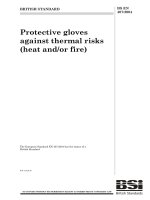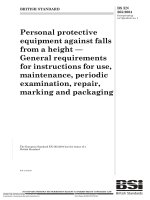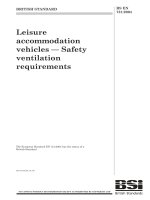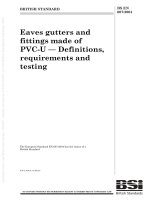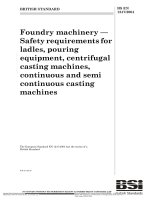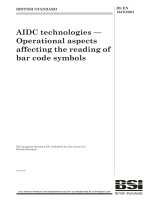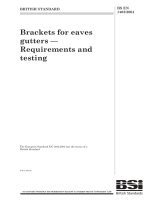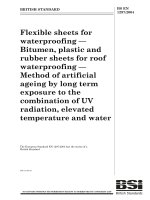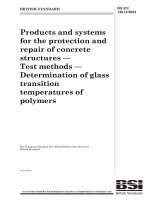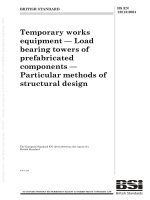Bsi bs en 00403 2004
Bạn đang xem bản rút gọn của tài liệu. Xem và tải ngay bản đầy đủ của tài liệu tại đây (668.68 KB, 34 trang )
EN 403
EUROPEAN STANDARD
NORME EUROPÉENNE
EUROPÄISCHE NORM
May 2004
ICS 13.340.30
Supersedes EN 403:1993
English version
Respiratory protective devices for self-rescue - Filtering devices
with hood for escape from fire - Requirements, testing, marking
Appareils de protection respiratoire pour l'évacuation Appareils filtrants avec cagoule pour l'évacuation d'un
incendie - Exigences, essais, marquage
Atemschutzgeräte für Selbstrettung - Filtergeräte mit
Haube zur Selbstrettung bei Bränden - Anforderungen,
Prüfung, Kennzeichnung
This European Standard was approved by CEN on 16 January 2004.
CEN members are bound to comply with the CEN/CENELEC Internal Regulations which stipulate the conditions for giving this European
Standard the status of a national standard without any alteration. Up-to-date lists and bibliographical references concerning such national
standards may be obtained on application to the Central Secretariat or to any CEN member.
This European Standard exists in three official versions (English, French, German). A version in any other language made by translation
under the responsibility of a CEN member into its own language and notified to the Central Secretariat has the same status as the official
versions.
CEN members are the national standards bodies of Austria, Belgium, Cyprus, Czech Republic, Denmark, Estonia, Finland, France,
Germany, Greece, Hungary, Iceland, Ireland, Italy, Latvia, Lithuania, Luxembourg, Malta, Netherlands, Norway, Poland, Portugal, Slovakia,
Slovenia, Spain, Sweden, Switzerland and United Kingdom.
EUROPEAN COMMITTEE FOR STANDARDIZATION
COMITÉ EUROPÉEN DE NORMALISATION
EUROPÄISCHES KOMITEE FÜR NORMUNG
Management Centre: rue de Stassart, 36
© 2004 CEN
All rights of exploitation in any form and by any means reserved
worldwide for CEN national Members.
B-1050 Brussels
Ref. No. EN 403:2004: E
EN 403:2004 (E)
Contents
Page
Foreword............................................................................................................................................................. 4
Introduction ........................................................................................................................................................ 5
1
Scope ..................................................................................................................................................... 6
2
Normative references ........................................................................................................................... 6
3
Terms and definitions........................................................................................................................... 6
4
Description ............................................................................................................................................ 7
5
Classification......................................................................................................................................... 7
6
6.1
6.2
6.3
6.4
6.5
6.6
6.7
6.8
6.9
6.10
6.10.1
6.10.2
6.11
6.11.1
6.11.2
6.12
6.13
6.14
6.15
6.16
6.17
6.17.1
6.17.2
6.17.3
6.18
6.19
6.20
6.21
6.22
Requirements ........................................................................................................................................ 7
General................................................................................................................................................... 7
Ergonomics ........................................................................................................................................... 7
Design .................................................................................................................................................... 7
Materials................................................................................................................................................. 7
Mass ....................................................................................................................................................... 8
Conditioning .......................................................................................................................................... 8
Connections .......................................................................................................................................... 8
Packaging .............................................................................................................................................. 8
Practical performance .......................................................................................................................... 8
Leakage.................................................................................................................................................. 8
Inward leakage excluding filter penetration (breathing zone).......................................................... 8
Leakage into ocular zone ..................................................................................................................... 9
Filter ....................................................................................................................................................... 9
Gas capacity .......................................................................................................................................... 9
Filter penetration................................................................................................................................... 9
Valves..................................................................................................................................................... 9
Breathing resistance .......................................................................................................................... 10
Flammability ........................................................................................................................................ 10
Carbon dioxide content of inhalation air.......................................................................................... 10
Head harness....................................................................................................................................... 10
Vision ................................................................................................................................................... 10
Visor ..................................................................................................................................................... 10
Impairment of vision........................................................................................................................... 10
Field of vision ...................................................................................................................................... 10
Sealing ................................................................................................................................................. 10
Integrity of filtering smoke hood at high carbon monoxide concentrations................................ 11
Ingress of humidity............................................................................................................................. 11
Temperature of inhaled air................................................................................................................. 11
Communication ................................................................................................................................... 11
7
7.1
7.2
7.3
7.4
7.4.1
7.4.2
7.4.3
7.4.4
7.4.5
7.4.6
Testing ................................................................................................................................................. 11
General................................................................................................................................................. 11
Nominal values and tolerances ......................................................................................................... 11
Visual inspection ................................................................................................................................ 11
Conditioning ........................................................................................................................................ 12
General................................................................................................................................................. 12
Mechanical strength ........................................................................................................................... 12
Impact................................................................................................................................................... 12
Resistance of packaging to puncture and tear................................................................................ 12
Temperature ........................................................................................................................................ 13
Pressure changes ............................................................................................................................... 13
2
EN 403:2004 (E)
7.5
7.5.1
7.5.2
7.6
7.6.1
7.6.2
7.7
7.7.1
7.7.2
7.7.3
7.8
7.9
7.10
7.10.1
7.10.2
7.10.3
7.11
7.12
Practical performance test .................................................................................................................13
General..................................................................................................................................................13
Exercises ..............................................................................................................................................14
Leakage ................................................................................................................................................14
Inward leakage excluding filter penetration (breathing zone) ........................................................14
Leakage into ocular zone....................................................................................................................14
Gas capacity.........................................................................................................................................15
General..................................................................................................................................................15
Carbon monoxide test.........................................................................................................................15
Other test gases...................................................................................................................................17
Filter penetration .................................................................................................................................17
Breathing resistance ...........................................................................................................................17
Flammability.........................................................................................................................................17
Test specimen......................................................................................................................................17
Apparatus .............................................................................................................................................17
Procedure .............................................................................................................................................17
Carbon dioxide content of the inhalation air ....................................................................................18
Connections .........................................................................................................................................18
8
8.1
8.2
8.3
Marking .................................................................................................................................................18
General..................................................................................................................................................18
Filtering smoke hood or package ......................................................................................................18
Package ................................................................................................................................................18
9
Information supplied by the manufacturer .......................................................................................19
Annex A (informative) Method for the determination of wet bulb temperature of the inhaled air ............28
Annex ZA (informative) Clauses of this European Standard addressing essential requirements or
other provisions of EU Directives......................................................................................................30
3
EN 403:2004 (E)
Foreword
This document (EN 403:2004) has been prepared by Technical Committee CEN/TC 79 “Respiratory protective
devices”, the secretariat of which is held by DIN.
This European Standard shall be given the status of a national standard, either by publication of an identical
text or by endorsement, at the latest by November 2004, and conflicting national standards shall be withdrawn
at the latest by November 2004.
This document supersedes EN 403:1993.
This document has been prepared under a mandate given to CEN by the European Commission and the
European Free Trade Association, and supports essential requirements of EU Directive(s).
For relationship with EU Directive(s), see informative annex ZA, which is an integral part of this document.
Annex A is informative.
According to the CEN/CENELEC Internal Regulations, the national standards organizations of the following
countries are bound to implement this European Standard: Austria, Belgium, Cyprus, Czech Republic,
Denmark, Estonia, Finland, France, Germany, Greece, Hungary, Iceland, Ireland, Italy, Latvia, Lithuania,
Luxembourg, Malta, Netherlands, Norway, Poland, Portugal, Slovakia, Slovenia, Spain, Sweden, Switzerland
and United Kingdom.
4
EN 403:2004 (E)
Introduction
A given respiratory protective device can only be approved when the individual components satisfy the
requirements of the test specification which may be a complete standard or part of a standard, and practical
performance tests have been carried out successfully on complete devices where specified in the appropriate
standard. If for any reason a complete device is not tested then simulation of the device is permitted provided
the respiratory characteristics and mass distribution are similar to those of the complete device.
5
EN 403:2004 (E)
1
Scope
This European Standard refers to filtering devices with a hood for personal escape from particulate matter,
carbon monoxide and other toxic gases produced by fire. It specifies minimum requirements for this device
which is for single use. It does not cover devices designed for use in circumstances where there is or might be
an oxygen deficiency (oxygen less than 17 % by volume).
Two types of devices are specified; namely, those designed to be carried on the person and those designed to
be stored.
This standard specifies devices primarily designed for adult users. Some devices may not be suitable for
children.
Laboratory and practical performance tests are included for the assessment of compliance with the
requirements.
2
Normative references
This European Standard incorporates by dated or undated reference, provisions from other publications.
These normative references are cited at the appropriate places in the text and the publications are listed
hereafter. For dated references, subsequent amendments to or revisions of any of these publications apply to
this European Standard only when incorporated in it by amendment or revision. For undated references the
latest edition of the publication referred to applies (including amendments).
EN 132:1998, Respiratory protective devices – Definitions of terms and pictograms
EN 134:1998, Respiratory protective devices – Nomenclature of components
EN 136, Respiratory protective devices - Full face masks - Requirements, testing, marking
EN 140, Respiratory protective devices - Half masks and quarter masks - Requirements, testing, marking
EN 141:2000, Respiratory protective devices - Gas filters and combined filters - Requirements, testing,
marking
EN 143:2000, Respiratory protective devices - Particle filters - Requirements, testing, marking
EN 405, Respiratory protective devices – Valved filtering half masks to protect against gases or gases and
particles – Requirements, testing, marking
EN 12941, Respiratory protective devices - Powered filtering devices incorporating a helmet or a hood Requirements, testing, marking
EN 13274-1, Respiratory protective devices - Methods of test - Part 1: Determination of inward leakage and
total inward leakage
EN 13274-4, Respiratory protective devices - Methods of test - Part 4: Flame tests
EN 13274-5:2001, Respiratory protective devices - Methods of test - Part 5: Climatic conditions
3
Terms and definitions
For the purposes of this European Standard, the terms and definitions given in EN 132:1998 and EN
134:1998 apply.
6
EN 403:2004 (E)
4
Description
A filtering device with a hood for self-rescue from fire (filtering smoke hood) is a respiratory protective device
dependent on the ambient atmosphere.
A complete device consists of a facepiece with combined filter and, if necessary, suitable packaging. It is not
intended that any disassembly or assembly be carried out by the user.
The facepiece of a filtering smoke hood can be the hood itself or a full face mask, half mask, quarter mask or
mouthpiece assembly connected to the hood. The combined filter is attached to the facepiece and is not
replaceable without tools.
5
Classification
Devices designed to be carried on the person are classified as 'M' and those for storage 'S'.
6
Requirements
6.1 General
In all tests all test samples shall meet the requirements.
6.2 Ergonomics
The requirements of this standard are intended to take account of the interaction between the wearer, the
respiratory protective device, and where possible the working environment in which the respiratory protective
device is likely to be used. See annex ZA.
6.3 Design
The apparatus shall be sufficiently robust to withstand the rough usage it is likely to receive in service with
respect to its classification.
The apparatus shall be designed so that there are no protruding parts or sharp edges likely to be caught on
projections in narrow passages.
No part of the apparatus likely to be in contact with the wearer shall have sharp edges or burrs.
The apparatus shall be designed to ensure its full function in any orientation.
Testing shall be done in accordance with 7.3 and 7.5.
6.4 Materials
Materials which come into direct contact with the wearer's skin shall not be known to be likely to cause
irritation or any other adverse effect to health.
All metallic parts shall be corrosion-resistant or protected against corrosion e.g. by packaging.
If materials sensitive to humidity are used in the device, they shall be protected against the effects of humidity
e.g. by suitable packaging.
Testing shall be done in accordance with 7.3, 7.4 and 7.5.
7
EN 403:2004 (E)
6.5 Mass
The mass of the ready-for-use device without packaging or carrying device shall not exceed 1000 g.
Testing shall be done in accordance with 7.1.
6.6 Conditioning
Prior to laboratory or practical performance tests all test specimen shall be conditioned.
Testing shall be done in accordance with 7.4.
6.7 Connections
Connections between components shall be designed such that they cannot be readily separated by the user.
Testing shall be done in accordance with 7.3.
The connection between filter and hood assembly shall withstand axially a tensile force of 50 N.
Testing shall be done in accordance with 7.12.
6.8 Packaging
The packaging shall be easy to open without tools.
Testing shall be done in accordance with 7.3.
6.9 Practical performance
The complete apparatus shall undergo practical performance tests. These general tests serve the purpose of
checking the apparatus for imperfections that cannot be determined by the tests described elsewhere in this
standard.
Where, in the opinion of the test house, approval is not granted because practical performance tests show the
apparatus has imperfections related to wearer's acceptance, the test house shall provide full details of those
parts of the practical performance tests which revealed these imperfections. This will enable other test houses
to duplicate the tests and assess the results thereof.
Testing shall be done in accordance with 7.5.
6.10 Leakage
6.10.1 Inward leakage excluding filter penetration (breathing zone)
For filtering smoke hoods fitted in accordance with the instructions for use, at least 46 out of the 50 individual
results for the inward leakage over each of the exercise periods as defined in 7.6.1 (i.e. 10 subjects x
5 exercise periods) shall be not greater than
5%
and, in addition, at least 8 out of the 10 individual wearer arithmetic means (10 subjects) for the inward
leakage, averaged over all exercise periods shall be not greater than
2%
8
EN 403:2004 (E)
Testing shall be done in accordance with 7.6.1.
6.10.2 Leakage into ocular zone
The leakage of the test agent shall not exceed 20 %.
Testing shall be done in accordance with 7.6.2.
6.11 Filter
6.11.1 Gas capacity
The breakthrough time shall not be less than 15 min when the test agents shown in Table 1 are used.
Testing shall be done in accordance with 7.7.
Table 1 — Test gas conditions
Test gas concentration in aira
Breakthrough concentrationb
ml/mc (= ppm)
ml/m (= ppm)
Propenal (acrolein)
100
0,5
Hydrogen chloride (HCl)
1000
5
Hydrogen cyanide (HCN)
400
10 c
Carbon monoxide
2500
200 d
Test gas
5000
7500
10 000
a
A deviation of ± 10 % from the required value shall be acceptable. The recorded breakthrough times shall be adjusted, if necessary,
by simple proportion to conform with the specified influent concentration.
b
The breakthrough concentration is an arbitrary value and it is used only to define the end point of the filter capacity under laboratory
testing conditions.
C
3
C2N2 may sometimes be present in the effluent air. The total concentration of (HCN + C2N2) shall not exceed 10 ml/m at
breakthrough.
d
Time weighted average in any single 5 min period.
6.11.2 Filter penetration
The filter shall meet the requirements of EN 143 for penetration of particle filter class P2 using sodium chloride
as test agent.
Testing shall be done in accordance with 7.8.
6.12 Valves
The complete device may be provided with one or more inhalation and exhalation valves. If the device is
equipped with valves, the valves shall operate correctly and independent of their orientation. They shall be
protected against dirt and mechanical damage.
Testing shall be done in accordance with 7.3 and 7.5.
9
EN 403:2004 (E)
6.13 Breathing resistance
The inhalation resistance shall not exceed 8 mbar and the exhalation resistance shall not exceed 3 mbar.
Testing shall be done in accordance with 7.9.
6.14 Flammability
The materials used shall not present a danger for the wearer and shall not be of highly flammable nature.
The filtering smoke hood or other exposed parts shall not continue to burn or present any additional hazard to
the wearer. It is not required that the filtering smoke hood still has to be useable after the test.
Testing shall be done in accordance with 7.3 and 7.10.
6.15 Carbon dioxide content of inhalation air
The carbon dioxide content of inhalation air (dead space) shall not exceed an average of 2 % by volume.
Testing shall be done in accordance with 7.11.
6.16 Head harness
If a harness is fitted it shall meet the requirements for the harness specified in EN 140.
6.17 Vision
6.17.1 Visor
The visors shall be reliably assembled to the device.
Testing shall be done in accordance with 7.3 and 7.5.
6.17.2 Impairment of vision
Visors shall not distort vision as determined in practical performance tests. There shall be no significant
impairment of vision by fogging as determined in practical performance tests.
Testing shall be done in accordance with 7.5.
6.17.3 Field of vision
The field of vision is acceptable if determined so in practical performance tests.
Testing shall be done in accordance 7.5.
6.18 Sealing
Each complete device or filter component shall be sealed and shall not be resealable except by the use of
special equipment. The sealing shall be such that it can readily be opened when necessary but not
inadvertently. When the packaging seal has been broken this shall be obvious by visual inspection.
Testing shall be done in accordance with 7.3 and 7.5.
10
EN 403:2004 (E)
6.19 Integrity of filtering smoke hood at high carbon monoxide concentrations
The device shall maintain its mechanical integrity and shall not present a hazard to the wearer.
Testing shall be done in accordance with 7.7.2.2 but with the variation to use 1,0 % by volume carbon
monoxide in air as the test atmosphere, and 7.3.
6.20 Ingress of humidity
If materials sensitive to humidity are used these materials shall be protected against humidity.
After conditioning in accordance with 7.4 the device shall meet the requirements of this standard.
6.21 Temperature of inhaled air
The temperature of the inhaled air shall not exceed 90 °C dry bulb and 50 °C wet bulb during the test duration
of 15 min.
Testing shall be done in accordance with 7.7.2.2 but with the variation to use 0,5 % by volume carbon
monoxide in air as the test atmosphere.
6.22 Communication
A person wearing the device shall be able to hear verbal communications from the test supervisor.
A person wearing the device shall be able to communicate verbally. This does not apply when the device is
equipped with a mouthpiece assembly.
Testing shall be done in accordance with 7.5.
7
Testing
7.1 General
If no special measuring devices or measuring methods are specified, commonly used methods and devices
should be applied.
Before performing tests involving human subjects, account should be taken of any national regulations
concerning the medical history, examination or supervision of the test subjects.
7.2 Nominal values and tolerances
Unless otherwise specified, the values stated in this standard are expressed as nominal values. Except for
temperature limits, values which are not stated as maxima or minima shall be subject to a tolerance of ± 5 %.
Unless otherwise specified, the ambient temperature for testing shall be from 16 °C to 32 °C, but for the
mechanical tests from 10 °C to 30 °C, and the temperature limits shall be subject to an accuracy of ± 1 °C.
7.3 Visual inspection
A visual inspection of the filtering devices shall be carried out and the appropriate results reported. The visual
inspection includes marking and information supplied by the manufacturer.
11
EN 403:2004 (E)
7.4 Conditioning
7.4.1
General
The conditioning procedures specified in 7.4.2 to 7.4.6 shall be applied sequentially to all test specimens.
The device shall be conditioned in the smallest packaging in which it is stored or carried.
7.4.2
Mechanical strength
The device shall be tested in its packaging in accordance with 8.3 of EN 141:2000 using 2 000 rotations for 'S'
type and 10 000 rotations for 'M' type.
7.4.3
Impact
The device shall be dropped in its packaging six times from a height of 1,5 m onto a smooth concrete surface
using different starting orientations.
This conditioning applies only to devices of 'M' type.
7.4.4
7.4.4.1
Resistance of packaging to puncture and tear
Principle
A striker is allowed to fall with a specified energy, point downwards onto the device packaged as described in
7.4.1. The packaging is then pulled out from under the point and inspected for punctures or tears.
7.4.4.2
Apparatus
Typical test equipment is shown in Figure 1. It consists mainly of
a)
striker;
b)
mounting arm for the striker: suitably pivoted;
c)
smooth polished steel base plate;
d)
spring balance.
7.4.4.3
Procedure
It shall be ensured that the effective force at rest of the mounting arm and the striker is 1N ± 2 %. The
necessary adjustment shall be made using a spring balance attached to the striker.
The test specimen in its packaging is placed under the striker such that when released the striker hits the
packaging.
The impact of the striker shall be from a height of 100 mm.
Leaving the striker in contact with the packaging, briskly pull the packaging away in the direction shown in
Figure 1.
Examine the packaging for any puncture or tear.
Repeat the procedure twice more to hit different areas of the packaging.
12
EN 403:2004 (E)
7.4.5
Temperature
The device shall be in the packaging as described in 7.4.1.
Testing shall be done in accordance with the following clauses of EN 13274-5:2001:
a)
6.2.2, 6.3.4 and 6.4.1;
b)
6.2.2, 6.3.2 and 6.4.1;
c)
6.2.8 and 6.4.2.
7.4.6
Pressure changes
Only devices classified as 'M' shall be exposed in its packaging as described in 7.4.1 consecutively to the
following pressure changes:
a)
2 pressure change cycles in a test chamber for negative pressure from ambient pressure to a differential
pressure of (-400 ± 10) mbar.
The final pressure shall be achieved in less than 20 s. After 60 s the pressure compensation shall be
started by venting the test chamber. The pressure compensation shall be achieved in less than 20 s.
b)
3 000 pressure change cycles in a test chamber for negative pressure from ambient pressure to a
differential pressure of (-300 ± 10) mbar.
The final pressure shall be achieved in less than 10 s. After 60 s the pressure compensation shall be
started and shall be achieved in less than 10 s.
If there is more than one test specimen in the test chamber to be exposed to the pressure changes then the
test specimens shall not be in contact with each other.
7.5 Practical performance test
7.5.1
General
For practical performance tests, only devices of the type which passed the laboratory testing shall be worn.
A total of 5 filtering smoke hoods shall be tested.
Prior to the test the filtering smoke hoods shall be examined to ensure that they are in good working condition
and can be used without hazard.
For test subjects shall be selected who are familiar with using such or similar devices.
Five test subjects shall be used for the practical performance tests. They shall be made familiar with the
device using the instructions for use.
The test subjects shall complete the exercises listed in 7.5.2 in a normally lit room at ambient atmosphere and
the test temperature and the humidity shall be recorded.
During the tests the device shall be subjectively assessed by the wearer and after the test, comments on the
following shall be recorded:
a)
harness comfort (if fitted);
13
EN 403:2004 (E)
b)
security of fastenings and couplings;
c)
accessibility of controls (if fitted);
d)
clarity of vision on the visor of the facepiece;
e)
the visibility of a sign consisting of letters 100 mm in height at a distance of 6 m;
f)
communication with a test supervisor;
g)
any other comments reported by the wearer on request.
7.5.2
Exercises
a)
walking on the level with headroom of (1,3 ± 0,2) m for 5 min;
b)
crawling on the level with headroom of (0,7 ± 0,05) m for 5 min;
c) filling a small basket (Figure 2, approx. volume = 8 l) with "rubber chippings" or other suitable material
from a hopper which stands 1,5 m high and has an opening at the bottom to allow the contents to be
shovelled out and a further opening at the top where the basket full of rubber chippings shall be returned.
The subject shall stoop or kneel as he wishes and fill the basket with rubber chippings. He shall then lift
the basket and empty the contents back into the hopper. This shall be repeated 15 times in 5 min.
7.6 Leakage
7.6.1
Inward leakage excluding filter penetration (breathing zone)
Test subjects, number of test specimen and preparation of test specimen in accordance with EN 405.
Testing in accordance with EN 13274-1, test method 1 using sulfur hexafluoride as test agent.
7.6.2
7.6.2.1
Leakage into ocular zone
Number of test specimens and test subjects
For the test 10 test specimen and 10 test subjects shall be used.
7.6.2.2
Preparation of test specimen
The visor in the hood shall be prepared by perforating such that a sampling probe and a thin air supply hose
can be inserted in a leak tight manner by appropriate plugs.
The sampling probe shall be positioned inside the hood on one side of the test subject at eye level. The port
for the air supply hose shall be positioned on the other side slightly displaced from eye level, so that the test
subject will not be distressed by the pressure compensating air flow. In the middle between the ports for the
sampling probe and the air supply a third hole shall be punched for connecting a sensitive differential pressure
meter (sensitivity < 0,01 mbar).
7.6.2.3
Setting-up procedure
The test subject wearing the hood prepared as described in 7.6.2.2 shall stand on a treadmill.
A continuous sample flow rate of 0,5 l/min shall be fed through the sampling line to the flame photometer and
shall be diluted with clean air, if necessary, to achieve the minimum flow rate required by the photometer.
14
EN 403:2004 (E)
Clean air shall be fed through the air supply at a flow rate of 0,5 l/min into the hood. Adjustments to the air
flow necessary to ensure that the pressure in the hood and ambient are the same shall be made while the test
subject is standing without any movement.
NOTE
Sometimes it may be necessary for the test subject to hold his breath for this procedure.
7.6.2.4
Test procedure
Testing shall be done in accordance with EN 12941 using sodium chloride as test agent.
At the end of the test the challenge concentration in the test chamber shall be measured using the same flow
rates and diluting conditions as were employed for measuring the in-hood concentrations.
7.6.2.5
Expression of results
The leakage into the ocular area LH shall be calculated from measurements made over the last 100 s of each
of the exercise periods to avoid carry over of results from one exercise to the other.
LH (%) =
concentration at eye level
x 100
challenge concentration
7.7 Gas capacity
7.7.1
General
The gas capacity shall be tested with 3 filters for each test gas for each test condition. When one filter of a
multiple filter device is tested separately, the air flow specified for a test shall be divided by the number of
filters through which the airflow is proportioned.
7.7.2
7.7.2.1
Carbon monoxide test
Apparatus
Schematic diagrams of test arrangements that have been found suitable are given in Figures 3, 4, 5 and 6.
They mainly consist of
a)
breathing machine equipped with solenoid valves controlled by the breathing machine;
b)
humidifier;
c)
flow meters for air and carbon monoxide;
d)
test chamber equipped with sampling ports and exhaust;
e)
carbon monoxide analysers;
f)
means of measurement of pressure, temperature and moisture content;
g)
'Sheffield' dummy or suitable adapter;
h)
supply of carbon monoxide.
15
EN 403:2004 (E)
7.7.2.2
Procedure
The hood to be tested shall be mounted on the dummy head (Sheffield). The filter, if tested separately, shall
be mounted on a suitable adapter. The test shall be carried out including the valves of the hood, if applicable.
NOTE 1 It may be necessary to use a sealant to ensure an effective seal between the hood and the dummy head
(Sheffield) or adapter respectively.
With a flow of not less than 100 l/min of air with carbon monoxide and water vapour content fed into the test
chamber via control valves and flow meters the following conditions in the test chamber shall be established
using the breathing machine set to 20 cycles/min and 1,5 l/stroke:
Concentration of carbon monoxide
0,25 % by volume
Humidity (moisture content of test atmosphere)
20,7 g/m3
Temperature of test atmosphere
(25 ± 1) °C
Temperature of exhaled air
(37 ± 1) °C
Humidity of exhaled air
95 - 100 %
The temperature and humidity of the test atmosphere and exhalation air shall be controlled by using suitable
conditioners.
The carbon monoxide and water vapour concentrations as well as the differential pressure in the test chamber
2,5 cm in front of the air inlet of the test specimen shall be monitored and recorded continuously during the
test.
NOTE 2
The effect of differential pressure and of the dilution of the challenge atmosphere by exhaled air shall be taken
into account and the concentration of carbon monoxide and moisture shall be adjusted accordingly.
3
The breathing resistance and the carbon monoxide concentration (ml/m ) shall be measured and recorded
continuously.
When tested against 0,5 % by volume carbon monoxide in air as test atmosphere
the dry bulb temperature of the inhaled air shall be measured using a fast response thermocouple (for
example NiCr-Ni 0,2 mm diameter);
the moisture content of the inhaled air shall be measured continuously. A suitable method is given in
annex A.
7.7.2.3
Other concentrations
The test shall be repeated but with the variation to use 0,5 %, 0,75 %, and 1,0 % by volume carbon monoxide
in air until all four values have been used.
NOTE
Four concentrations are used to establish the catalytic characteristics of the materials and the configuration of
the device.
7.7.2.4
Breakthrough criteria
The carbon monoxide concentration of the inhaled air shall not exceed 200 ml/m3 time weighted average in
any single 5 min period.
16
EN 403:2004 (E)
7.7.3
Other test gases
The conditions shown in Table 1 shall be used for testing with the gases specified in 6.11.1.
The filter under test shall be connected to a test rig generating a continuous air flow of 30 l/min (± 3 %) with
the required concentration of test gas.
The test atmosphere shall be at a temperature of (20 ± 1) °C and shall have a relative humidity of (70 ± 5) %.
When hydrogen chloride is used as a test gas the relative humidity shall be (30 ± 10) %.
The breakthrough concentration shall be monitored with a maximum error of 20 %. The breakthrough time
shall be stated in minutes.
7.8 Filter penetration
Testing in accordance with 8.7.2 of EN 143:2000 using 3 filters and sodium chloride aerosol.
NOTE
If the filter cannot be tested separately, it may be necessary to use a sealant to ensure an effective seal
between the hood and the Sheffield dummy head or adapter respectively.
When one filter of a multiple filter device is tested separately, the air flow specified for a test shall be divided
by the number of filters through which the air flow is proportioned.
7.9 Breathing resistance
Two filtering smoke hoods shall be tested.
The ready-for-use device shall be mounted on a Sheffield dummy head. The breathing resistance shall be
determined at the mouth of the dummy head using a breathing machine (adjusted to 1,5 l/stroke, 20
cycles/min) using the procedure given at 7.7.2.2. The flow rate at which the resistance is measured shall be
corrected to 23 °C and 1 bar absolute.
7.10 Flammability
7.10.1 Test specimen
Two filtering smoke hoods shall be tested.
7.10.2 Apparatus
The test rig described in EN13274-4 method 1 is used.
7.10.3 Procedure
The filtering smoke hood shall be fitted on the metallic dummy head. If the filtering smoke hood is not
equipped with a head harness, the material of the filtering smoke hood shall be clamped in an appropriate
clamping device such that the material is horizontal.
The distance between the outer surface of the filtering smoke hood and the burner tips shall be adjusted to
250 mm.
The pressure reducer shall be adjusted to approximately 0,15 bar. It shall be ensured that the control device
for propane gas on the burners is fully opened and that the control device for air is fully closed. The
temperature of the flame 250 mm above the burner tip shall be (800 ± 50) °C.
The filtering smoke hood (on the dummy head) or the filtering smoke hood material (in the clamp) shall be
rotated once through the flame at a velocity of (6 ± 0,5) cm/s.
17
EN 403:2004 (E)
Where components such as valve(s), filter(s) etc. are arranged on other parts of the filtering smoke hood, the
test shall be repeated with these components at the appropriate height (250 mm) above the flame.
After passing through the flame it shall be recorded whether or not the filtering smoke hood or other
components continued to burn or presented any additional potential hazard to a wearer.
7.11 Carbon dioxide content of the inhalation air
Two filtering smoke hood shall be tested.
Testing shall be done in accordance with EN 136.
7.12 Connections
Two filtering smoke hood shall be tested.
Test time shall be 10 s. The filtering smoke hood shall be supported on a dummy head which shall be
adjusted such that the load can be applied axially to the connection as shown in Figure 7.
8
Marking
8.1 General
All the markings shall be readable and durable.
Sub-assemblies and piece parts with considerable bearing on safety shall be marked so that they can be
identified.
8.2 Filtering smoke hood or package
All filtering smoke hoods or at least the packaging shall be marked with
a)
the dated number of this European Standard and classification, if applicable;
b)
the manufacturer, supplier or importer shall be identified by name, trademark, or other means of
identification;
c)
manufacturer’s model designation.
8.3 Package
The package shall be marked at least with the following information:
a)
class i.e. ‘M’ or ‘S’;
b)
date of manufacture (year and month) and the end of shelf life or date for next inspection. Equivalent
pictograms can be used (Figure 8);
c)
manufacturer’s recommended conditions of storage (at least the temperature and humidity) or equivalent
pictogram as shown in Figure 8;
d)
the sentence ”See information supplied by the manufacturer.“ at least in the official language(s) of the
country of destination or the appropriate pictogram as shown in Figure 8;
18
